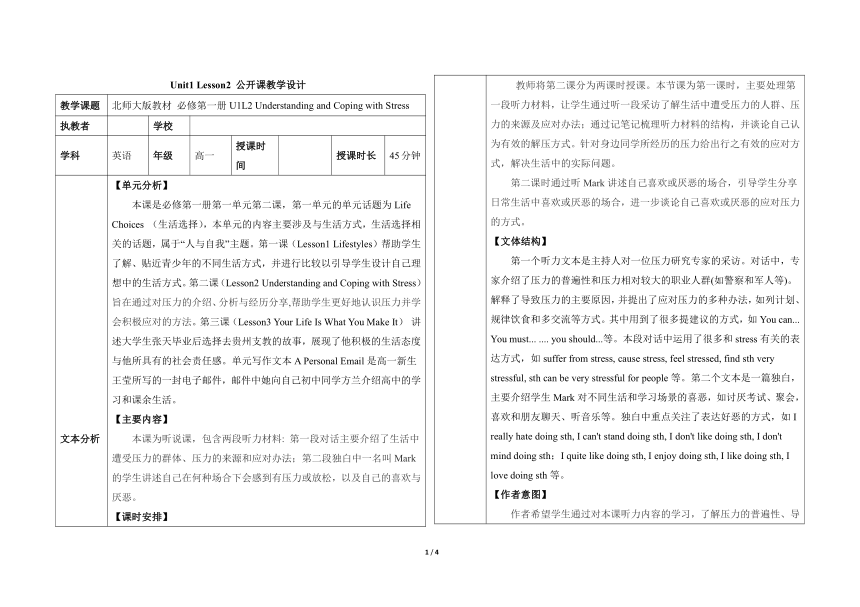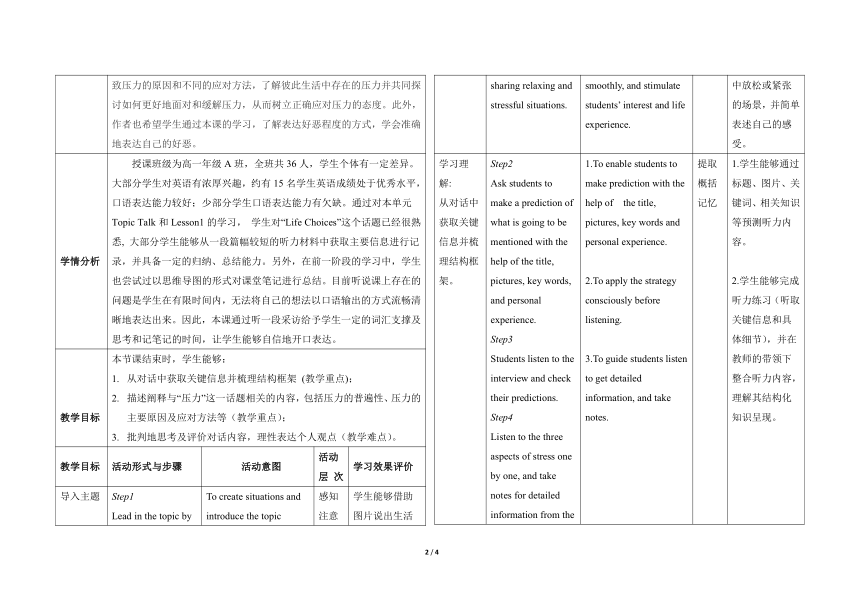北师大版(2019)必修 第一册Unit 1 Life Choices Lesson 2 Understanding and Coping with Stress教学设计(表格式)
文档属性
| 名称 | 北师大版(2019)必修 第一册Unit 1 Life Choices Lesson 2 Understanding and Coping with Stress教学设计(表格式) |  | |
| 格式 | doc | ||
| 文件大小 | 39.5KB | ||
| 资源类型 | 教案 | ||
| 版本资源 | 北师大版(2019) | ||
| 科目 | 英语 | ||
| 更新时间 | 2023-03-05 13:36:27 | ||
图片预览


文档简介
Unit1 Lesson2 公开课教学设计
教学课题 北师大版教材 必修第一册U1L2 Understanding and Coping with Stress
执教者 学校
学科 英语 年级 高一 授课时间 授课时长 45分钟
文本分析 【单元分析】本课是必修第一册第一单元第二课,第一单元的单元话题为Life Choices (生活选择),本单元的内容主要涉及与生活方式,生活选择相关的话题,属于“人与自我”主题。第一课(Lesson1 Lifestyles)帮助学生了解、贴近青少年的不同生活方式,并进行比较以引导学生设计自己理想中的生活方式。第二课(Lesson2 Understanding and Coping with Stress) 旨在通过对压力的介绍、分析与经历分享,帮助学生更好地认识压力并学会积极应对的方法。第三课(Lesson3 Your Life Is What You Make It) 讲述大学生张天毕业后选择去贵州支教的故事,展现了他积极的生活态度与他所具有的社会责任感。单元写作文本A Personal Email是高一新生王莹所写的一封电子邮件,邮件中她向自己初中同学方兰介绍高中的学习和课余生活。【主要内容】本课为听说课,包含两段听力材料: 第一段对话主要介绍了生活中遭受压力的群体、压力的来源和应对办法;第二段独白中一名叫Mark的学生讲述自己在何种场合下会感到有压力或放松,以及自己的喜欢与厌恶。【课时安排】 教师将第二课分为两课时授课。本节课为第一课时,主要处理第一段听力材料,让学生通过听一段采访了解生活中遭受压力的人群、压力的来源及应对办法;通过记笔记梳理听力材料的结构,并谈论自己认为有效的解压方式。针对身边同学所经历的压力给出行之有效的应对方式,解决生活中的实际问题。 第二课时通过听Mark讲述自己喜欢或厌恶的场合,引导学生分享日常生活中喜欢或厌恶的场合,进一步谈论自己喜欢或厌恶的应对压力的方式。【文体结构】第一个听力文本是主持人对一位压力研究专家的采访。对话中,专家介绍了压力的普遍性和压力相对较大的职业人群(如警察和军人等)。解释了导致压力的主要原因,并提出了应对压力的多种办法,如列计划、规律饮食和多交流等方式。其中用到了很多提建议的方式,如You can... You must... .... you should...等。本段对话中运用了很多和stress有关的表达方式,如suffer from stress, cause stress, feel stressed, find sth very stressful, sth can be very stressful for people等。第二个文本是一篇独白, 主要介绍学生Mark对不同生活和学习场景的喜恶,如讨厌考试、聚会,喜欢和朋友聊天、听音乐等。独白中重点关注了表达好恶的方式,如I really hate doing sth, I can't stand doing sth, I don't like doing sth, I don't mind doing sth;I quite like doing sth, I enjoy doing sth, I like doing sth, I love doing sth等。【作者意图】作者希望学生通过对本课听力内容的学习,了解压力的普遍性、导致压力的原因和不同的应对方法,了解彼此生活中存在的压力并共同探讨如何更好地面对和缓解压力,从而树立正确应对压力的态度。此外,作者也希望学生通过本课的学习,了解表达好恶程度的方式,学会准确地表达自己的好恶。
学情分析 授课班级为高一年级A班,全班共36人,学生个体有一定差异。大部分学生对英语有浓厚兴趣,约有15名学生英语成绩处于优秀水平,口语表达能力较好;少部分学生口语表达能力有欠缺。通过对本单元Topic Talk和Lesson1的学习, 学生对“Life Choices”这个话题已经很熟悉, 大部分学生能够从一段篇幅较短的听力材料中获取主要信息进行记录,并具备一定的归纳、总结能力。另外,在前一阶段的学习中,学生也尝试过以思维导图的形式对课堂笔记进行总结。目前听说课上存在的问题是学生在有限时间内,无法将自己的想法以口语输出的方式流畅清晰地表达出来。因此,本课通过听一段采访给予学生一定的词汇支撑及思考和记笔记的时间,让学生能够自信地开口表达。
教学目标 本节课结束时,学生能够:从对话中获取关键信息并梳理结构框架 (教学重点);描述阐释与“压力”这一话题相关的内容,包括压力的普遍性、压力的主要原因及应对方法等(教学重点);批判地思考及评价对话内容,理性表达个人观点(教学难点)。
教学目标 活动形式与步骤 活动意图 活动层 次 学习效果评价
导入主题 Step1Lead in the topic by sharing relaxing and stressful situations. To create situations and introduce the topic smoothly, and stimulate students’ interest and life experience. 感知注意 学生能够借助图片说出生活中放松或紧张的场景,并简单表述自己的感受。
学习理解:从对话中获取关键信息并梳理结构框架。 Step2Ask students to make a prediction of what is going to be mentioned with the help of the title, pictures, key words, and personal experience.Step3Students listen to the interview and check their predictions.Step4Listen to the three aspects of stress one by one, and take notes for detailed information from the interview. 1.To enable students to make prediction with the help of the title, pictures, key words and personal experience.2.To apply the strategy consciously before listening. 3.To guide students listen to get detailed information, and take notes. 提取概括记忆 1.学生能够通过标题、图片、关键词、相关知识等预测听力内容。2.学生能够完成听力练习(听取关键信息和具体细节),并在教师的带领下整合听力内容,理解其结构化知识呈现。
应用实践: 描述阐释与“压力”这一话题相关的内容(压力的普遍性、压力的主要原因及应对方法)。 Step5 Students summarize and interpret the detailed information from the interview. To have students summarize and interpret the detailed information of the topic. 整合描述阐释 学生能够借助笔记用自己的语言描述阐释压力的普遍性、压力的主要原因及应对方法。
迁移创新:批判地思考及评价对话内容,理性表达个人观点。 Step6 Lead students to think critically about the content of the interview and exchange their ideas about what the expert say about stress, then express their own opinions on the ways to reduce stress.Step7Watch a video about a boy who is talking about his stress in study and help the boy solve his problem.Step8Encourage students to work in pairs to talk about their stress and share the ways of coping with stress. 1.To invite students to think critically about the content of the interview and exchange their ideas about what the expert say about stress. To express their own opinions on the ways to reduce stress.2.To let students help solve the problem of the boy using what they have learnt. 3.To encourage students to work in pairs to talk about their stress and share the ways of coping with stress. 判断评价 1.学生能够批判性地看待专家观点,并在讨论后表达自己的观点。2.学生能够运用所学解决实际问题。3.学生能够谈论自己的压力并分享缓解压力的方法。
巩固 Step9Homework:Finish Ex.6 on page 13.Write about the kinds of stress students often suffer from, and the experiences or activities they like in coping with stress. To help students review what they have learnt and have students write about the kinds of stress they often suffer from, and the experiences or activities they like in coping with stress. 整合运用 学生能够完成作业, 梳理所学知识。运用所学解决自己实际生活中的问题,进行自我解压,自我调整。
2 / 4
教学课题 北师大版教材 必修第一册U1L2 Understanding and Coping with Stress
执教者 学校
学科 英语 年级 高一 授课时间 授课时长 45分钟
文本分析 【单元分析】本课是必修第一册第一单元第二课,第一单元的单元话题为Life Choices (生活选择),本单元的内容主要涉及与生活方式,生活选择相关的话题,属于“人与自我”主题。第一课(Lesson1 Lifestyles)帮助学生了解、贴近青少年的不同生活方式,并进行比较以引导学生设计自己理想中的生活方式。第二课(Lesson2 Understanding and Coping with Stress) 旨在通过对压力的介绍、分析与经历分享,帮助学生更好地认识压力并学会积极应对的方法。第三课(Lesson3 Your Life Is What You Make It) 讲述大学生张天毕业后选择去贵州支教的故事,展现了他积极的生活态度与他所具有的社会责任感。单元写作文本A Personal Email是高一新生王莹所写的一封电子邮件,邮件中她向自己初中同学方兰介绍高中的学习和课余生活。【主要内容】本课为听说课,包含两段听力材料: 第一段对话主要介绍了生活中遭受压力的群体、压力的来源和应对办法;第二段独白中一名叫Mark的学生讲述自己在何种场合下会感到有压力或放松,以及自己的喜欢与厌恶。【课时安排】 教师将第二课分为两课时授课。本节课为第一课时,主要处理第一段听力材料,让学生通过听一段采访了解生活中遭受压力的人群、压力的来源及应对办法;通过记笔记梳理听力材料的结构,并谈论自己认为有效的解压方式。针对身边同学所经历的压力给出行之有效的应对方式,解决生活中的实际问题。 第二课时通过听Mark讲述自己喜欢或厌恶的场合,引导学生分享日常生活中喜欢或厌恶的场合,进一步谈论自己喜欢或厌恶的应对压力的方式。【文体结构】第一个听力文本是主持人对一位压力研究专家的采访。对话中,专家介绍了压力的普遍性和压力相对较大的职业人群(如警察和军人等)。解释了导致压力的主要原因,并提出了应对压力的多种办法,如列计划、规律饮食和多交流等方式。其中用到了很多提建议的方式,如You can... You must... .... you should...等。本段对话中运用了很多和stress有关的表达方式,如suffer from stress, cause stress, feel stressed, find sth very stressful, sth can be very stressful for people等。第二个文本是一篇独白, 主要介绍学生Mark对不同生活和学习场景的喜恶,如讨厌考试、聚会,喜欢和朋友聊天、听音乐等。独白中重点关注了表达好恶的方式,如I really hate doing sth, I can't stand doing sth, I don't like doing sth, I don't mind doing sth;I quite like doing sth, I enjoy doing sth, I like doing sth, I love doing sth等。【作者意图】作者希望学生通过对本课听力内容的学习,了解压力的普遍性、导致压力的原因和不同的应对方法,了解彼此生活中存在的压力并共同探讨如何更好地面对和缓解压力,从而树立正确应对压力的态度。此外,作者也希望学生通过本课的学习,了解表达好恶程度的方式,学会准确地表达自己的好恶。
学情分析 授课班级为高一年级A班,全班共36人,学生个体有一定差异。大部分学生对英语有浓厚兴趣,约有15名学生英语成绩处于优秀水平,口语表达能力较好;少部分学生口语表达能力有欠缺。通过对本单元Topic Talk和Lesson1的学习, 学生对“Life Choices”这个话题已经很熟悉, 大部分学生能够从一段篇幅较短的听力材料中获取主要信息进行记录,并具备一定的归纳、总结能力。另外,在前一阶段的学习中,学生也尝试过以思维导图的形式对课堂笔记进行总结。目前听说课上存在的问题是学生在有限时间内,无法将自己的想法以口语输出的方式流畅清晰地表达出来。因此,本课通过听一段采访给予学生一定的词汇支撑及思考和记笔记的时间,让学生能够自信地开口表达。
教学目标 本节课结束时,学生能够:从对话中获取关键信息并梳理结构框架 (教学重点);描述阐释与“压力”这一话题相关的内容,包括压力的普遍性、压力的主要原因及应对方法等(教学重点);批判地思考及评价对话内容,理性表达个人观点(教学难点)。
教学目标 活动形式与步骤 活动意图 活动层 次 学习效果评价
导入主题 Step1Lead in the topic by sharing relaxing and stressful situations. To create situations and introduce the topic smoothly, and stimulate students’ interest and life experience. 感知注意 学生能够借助图片说出生活中放松或紧张的场景,并简单表述自己的感受。
学习理解:从对话中获取关键信息并梳理结构框架。 Step2Ask students to make a prediction of what is going to be mentioned with the help of the title, pictures, key words, and personal experience.Step3Students listen to the interview and check their predictions.Step4Listen to the three aspects of stress one by one, and take notes for detailed information from the interview. 1.To enable students to make prediction with the help of the title, pictures, key words and personal experience.2.To apply the strategy consciously before listening. 3.To guide students listen to get detailed information, and take notes. 提取概括记忆 1.学生能够通过标题、图片、关键词、相关知识等预测听力内容。2.学生能够完成听力练习(听取关键信息和具体细节),并在教师的带领下整合听力内容,理解其结构化知识呈现。
应用实践: 描述阐释与“压力”这一话题相关的内容(压力的普遍性、压力的主要原因及应对方法)。 Step5 Students summarize and interpret the detailed information from the interview. To have students summarize and interpret the detailed information of the topic. 整合描述阐释 学生能够借助笔记用自己的语言描述阐释压力的普遍性、压力的主要原因及应对方法。
迁移创新:批判地思考及评价对话内容,理性表达个人观点。 Step6 Lead students to think critically about the content of the interview and exchange their ideas about what the expert say about stress, then express their own opinions on the ways to reduce stress.Step7Watch a video about a boy who is talking about his stress in study and help the boy solve his problem.Step8Encourage students to work in pairs to talk about their stress and share the ways of coping with stress. 1.To invite students to think critically about the content of the interview and exchange their ideas about what the expert say about stress. To express their own opinions on the ways to reduce stress.2.To let students help solve the problem of the boy using what they have learnt. 3.To encourage students to work in pairs to talk about their stress and share the ways of coping with stress. 判断评价 1.学生能够批判性地看待专家观点,并在讨论后表达自己的观点。2.学生能够运用所学解决实际问题。3.学生能够谈论自己的压力并分享缓解压力的方法。
巩固 Step9Homework:Finish Ex.6 on page 13.Write about the kinds of stress students often suffer from, and the experiences or activities they like in coping with stress. To help students review what they have learnt and have students write about the kinds of stress they often suffer from, and the experiences or activities they like in coping with stress. 整合运用 学生能够完成作业, 梳理所学知识。运用所学解决自己实际生活中的问题,进行自我解压,自我调整。
2 / 4
同课章节目录
- Unit 1 Life Choices
- Lesson 1 Lifestyles
- Lesson 2 Understanding and Coping with Stress
- Lesson 3 Your Life Is What You Make It
- Unit 2 Sports and Fitness
- Lesson 1 The Underdog
- Lesson 2 Rules of the Game
- Lesson 3 Running and Fitness
- Unit 3 Celebrations
- Lesson 1 Spring Festival
- Lesson 2 Special Occasions
- Lesson 3 Memories of Christmas
